Invoices
Invoices are statements that define the amounts due by the customer as a result of a purchase for your product or service offerings. Depending on how the invoice is generated, they can be one-time or recurring. This guide will walk you through how to navigate through your invoices.
When logged into a Pelcro Instance, you can create, view, action and export invoices. All these actions can be performed under the "Billing > Invoices" tab.

The invoice will typically contain the following information:

- Invoice status
- Details about the customer
- Invoice issue date
- Invoice number
- Line item for the offering which was purchased
- Discounts which are applied to the invoice
- Collection method
- Total applicable taxes being collected
- Purchase order
- Subtotals and summaries for the entire purchase
- Payment status and details
- Hosted invoice URL on Stripe
- Invoice notes
- Payment link in case the invoice is open

Invoice Breakdown
Invoice Lifecycle
Typically, an invoice will go from one status to the other as it responds to different event triggers, such as user purchases, paying a subscription, or cancellations. This will happen automatically in a normal flow from the time they’re created to when they’re paid. Occasionally, in order for an invoice to go from a status to another, it will require a corresponding action to be taken from either the user or the admin.
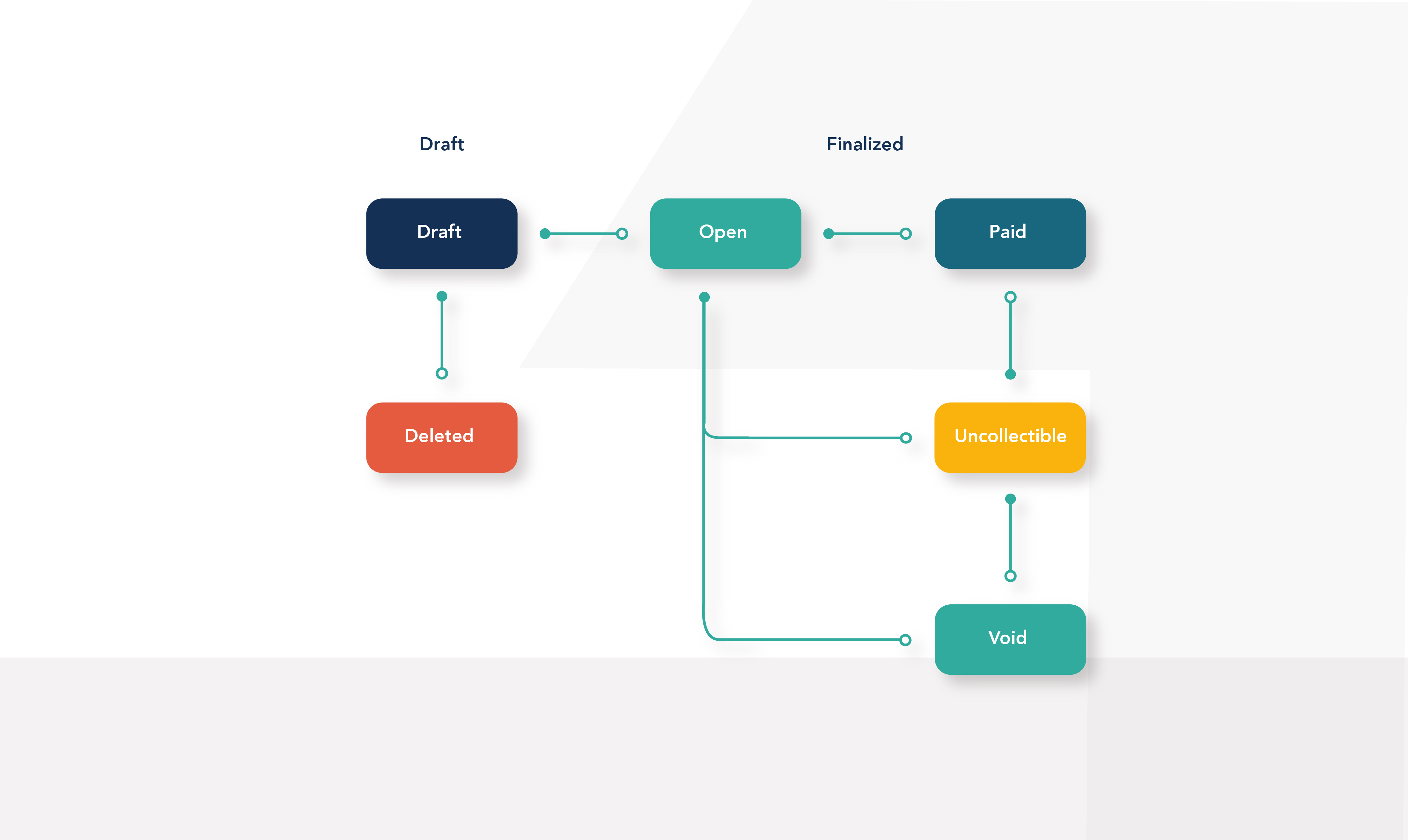
Invoice Lifecycle

Invoices which are visible to your customers will typically be either Open or Paid. The status section of the invoice will show you which status the invoice is currently in

Advance invoices
Advance invoices give your customers more control over their subscription payments. They can choose to pay ahead of time, helping them manage their finances and avoid surprises. This boosts satisfaction and loyalty. Finally, upfront payments let you plan and budget better, leading to stability and growth.
You can generate an advance invoice before the start of a phase, but this feature is only available for renewals. When an advance invoice is successfully paid, it will be labeled as "prepaid." It's important to note that advance invoices are for the next phase only, up to one phase ahead.
Finally, please bear in mind that advance invoices do not apply to e-commerce orders, providing a streamlined and focused process for your needs.
Invoice Types
Pelcro empowers you with two invoice types for comprehensive billing management:
- Automated Invoices
Automated invoices are automatically generated when a recurring service is activated or a one-time purchase is made. These invoices reflect the recurring charges associated with a subscription or the one-time cost of a purchase order.
- Standalone Invoices
Standalone invoices provide exceptional flexibility for independent billing scenarios. You can create invoices for any purpose, separate from subscriptions or purchase orders. This functionality is advantageous for various situations, including:
- Issuing invoices for one-time services rendered.
- Billing for expenses incurred outside of subscriptions.
- Sending invoices for prepayments or deposits.
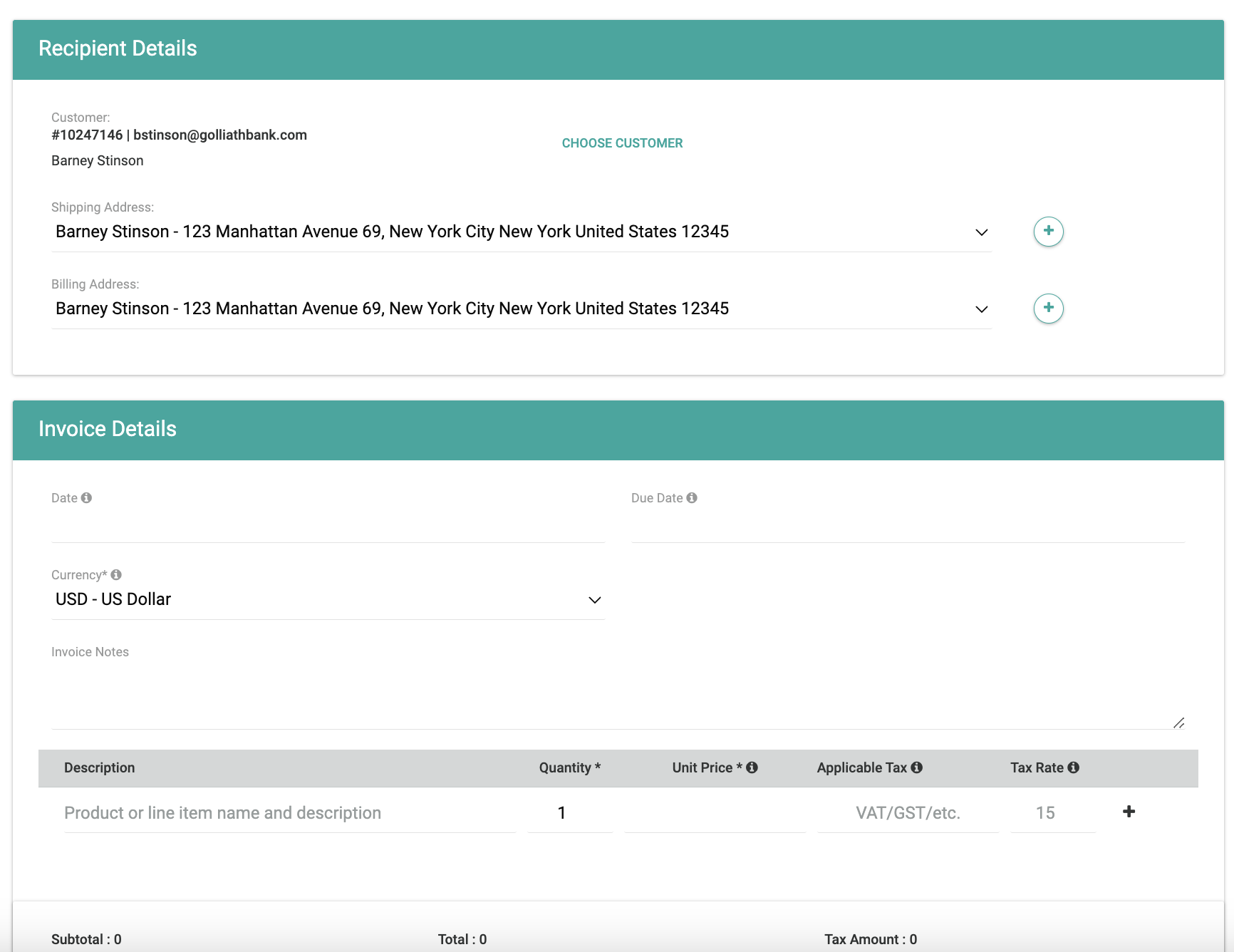
Invoice Status
Invoices can take on one of five statuses. These statuses allow you to draft and revise invoices before they finalize and before sending and attempting payment.
| Status | Description |
|---|---|
| Draft | Starting status for all invoices; at this point, the invoice can still be edited. |
| Open | The invoice has been created, and is now awaiting payment from the customer. It can no longer be edited. Send, void, mark uncollectible, or pay the invoice |
| Open (Past due) | Same as Open, but the invoice was not paid on time |
| Paid | The invoice is paid. Invoices are automatically marked as paid when payments are processed through Stripe, though you can manually mark invoices as paid to reflect out of band payments. |
| Uncollectible | This invoice was marked as uncollectible (as a result of customers not able to pay their debts for one reason or the other). It’s unlikely that this invoice will be paid, and it should be treated as bad debt on corresponding reports. |
| Void | This invoice was a mistake, not payable, and must be effectively canceled or deleted. Voiding an invoice effectively zeros its amounts in any reports, ensuring an accounting paper trail. Note that this status will appear if you've enabled the uncollectible feature. |
Invoice Webhook Triggers
| Status | Emitted Webhook | End Status |
|---|---|---|
| Draft | invoice.deleted | Deleted |
| Draft | invoice.created | Open |
| Draft | invoice.upcoming | Paid |
| Open | invoice.payment_succeeded | Paid |
| Open | invoice.payment_failed | Open |
| Open | invoice.upcoming | Paid |
| Open | invoice.sent | Open |
| Open | invoice.voided | Void |
| Open | invoice.marked_uncollectible | Uncollectible |
| Uncollectible | invoice.payment_succeeded | Paid |
| Uncollectible | invoice.payment_failed | Uncollectible |
| Uncollectible | invoice.voided | Void |
Online Invoice Lifecycle
Automatically paid invoices have the following lifecycle:
- A draft invoice is created. This triggers an invoice.created notification.
- About an hour after creation, the invoice is finalized (changes are no longer permitted). The status of the invoice is open and Pelcro automatically attempts to pay it using the default payment method registered under the customer.
- If the payment is successful, an invoice.payment_succeeded notification is triggered, and the invoice’s status will change to paid.
- If the payment fails or the customer does not have a valid payment method, an invoice.payment_failed notification is sent. In which case, the subscription state along with invoice status changes to past_due.
- An automatic payment is attempted on the invoice shortly after it is generated.
- Pelcro never notifies the customer about the invoice, however, the customer can receive an email receipt, if you have it enabled.
Offline Invoice Lifecycle
Manually paid invoices have the following lifecycle:
- A draft invoice is created. This triggers an invoice.created notification.
- About an hour after creation, the invoice is finalized (changes are no longer permitted). The status of the invoice is open.
- At a later point, the customer pays the invoice by sending an ACH credit transfer or by cheque, and the invoice is marked as paid. An invoice.payment_succeeded notification is triggered, and the invoice’s status will change to paid.
- If the customer does not pay the invoice before the due date, or sends an amount that is not automatically reconciled, the subscription state along with invoice status changes to past_due.
Invoice Credits
Each customer account can have a balance for which credit or debit adjustments can be applied with future invoices. Some actions will credit on customers. For example, when a customer changes from one subscription plan to another, and refunds are allowed, the customer will be refunded with a prorated amount. These credits are captured in credit notes, which represent the amount credited to specific item. Credits reduce the invoice due amount. For more information on credit notes and how they affect invoicing, please refer to the Credit Notes guide.
Invoice Discounts
Discounts which appear on the invoice will usually result either from your gifts or your coupons. The total discount for the whole invoice appears at the bottom of the invoice, including information about the corresponding coupon/gift details.
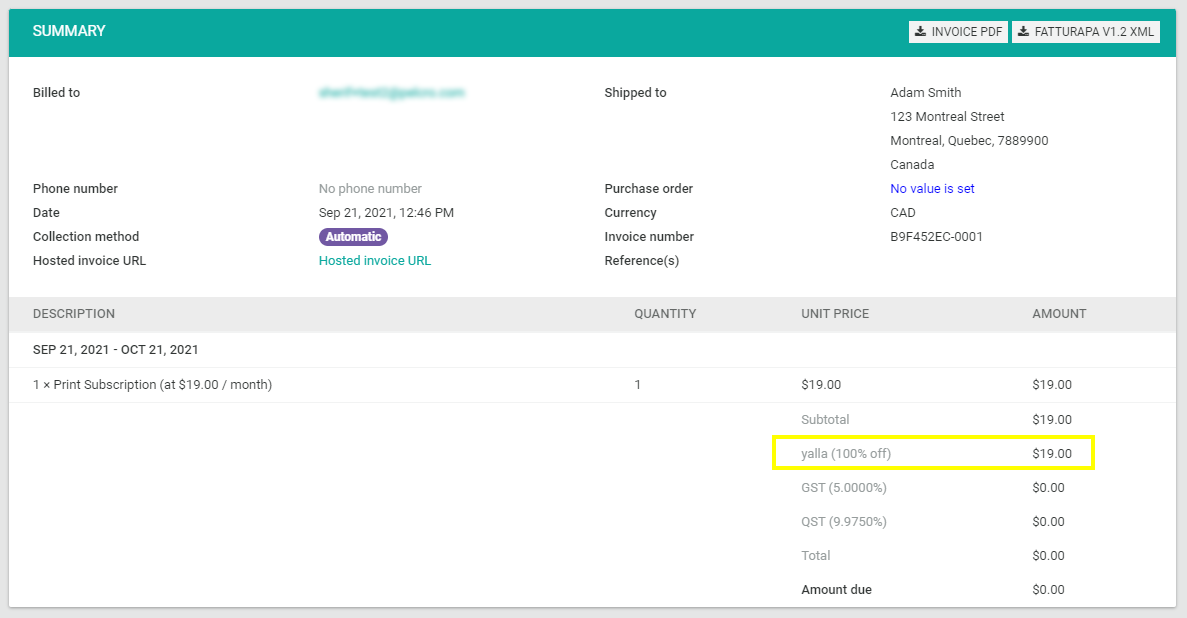
Invoice Taxes
Taxes which are applicable to the subscription according to your tax configuration will be listed under the subtotals at the bottom of the invoice. For more information on automatic tax calculation, please refer to the Taxes Guide as well as the Tax Reference pages.
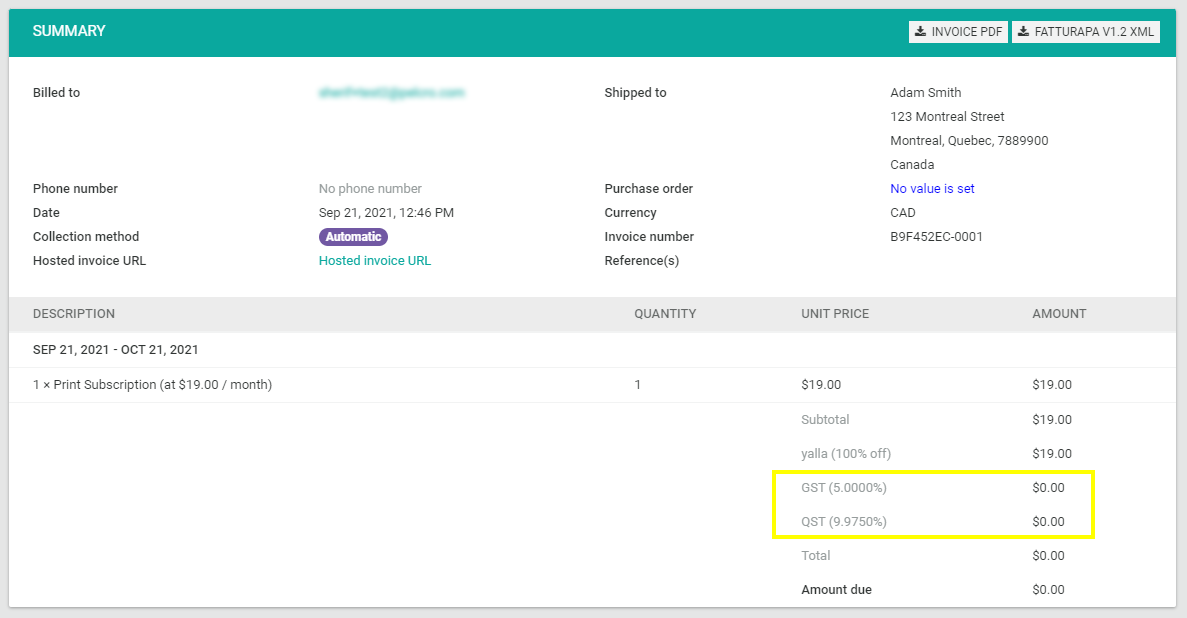
Invoice Actions
Listing Invoices
To view your invoices:
- On your Dashboard, hover over your left navigation menu. Choose "Billing" > "Invoices".
- You'll be redirected to the invoices page, where you can view and manage all your current invoices, and action them as needed

Once you arrive at the Invoices page, you will see a detailed list view of all invoices, categorized into six different tabs according to their status: All, Draft, Open, Past due, Paid, or Uncollectible.
To help navigate you through your invoices, you will also find the following:
- Search button: allows you to search your database for invoices based on invoice Number and Customer Email.
- Export button: allows you to export your invoices list, along with all the listed details into CSV format. You can control the range of the invoices data to export using the date filters in the top right.
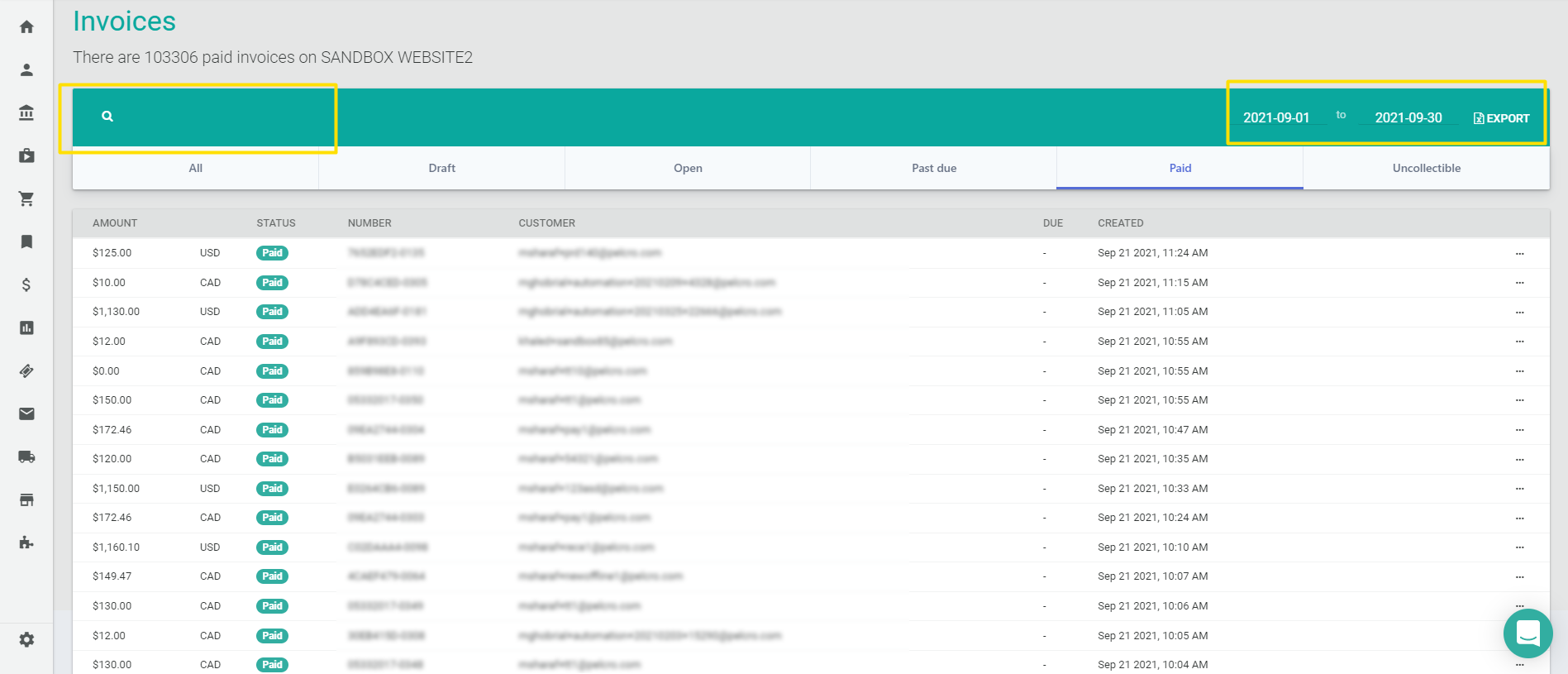
You can also list invoices using one of the following ways:
- Pelcro's JavaScript SDK
- Pelcro's Core API
Viewing Invoice Details
If you want to view more details of a specific invoice, click on invoice number line item, or alternatively, click on the ellipsis "···" menu to the right-most column of the desired subscription, followed by "View invoice".
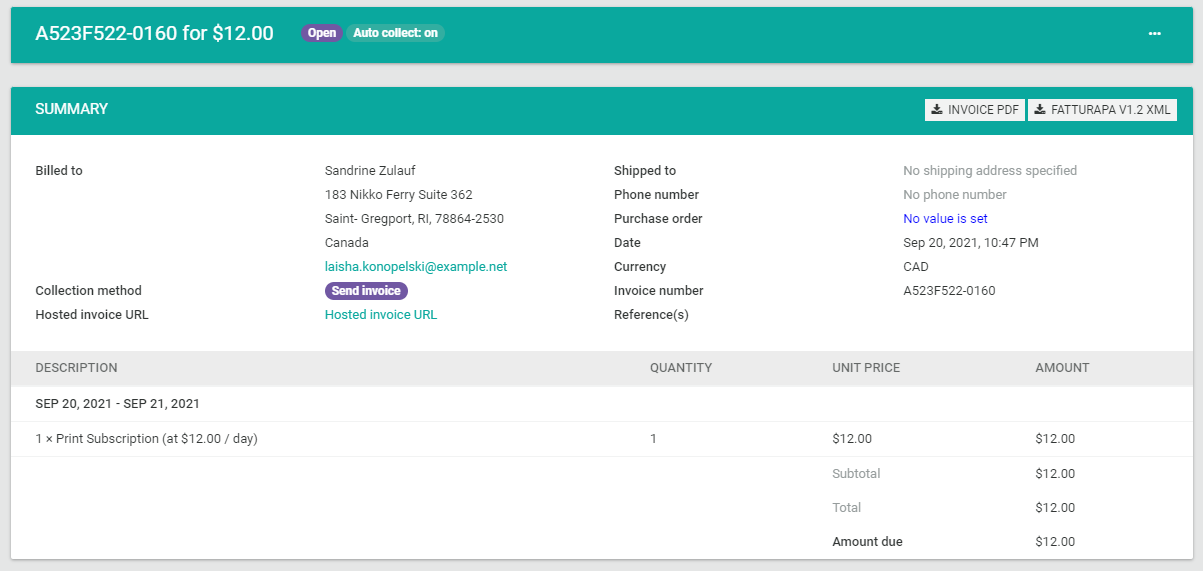
The invoice details page will include the following:
- Invoice status, including amount due or paid
- Details about the customer: name, contact information (email and phone number), and addresses
- Dates on which the invoice was issued and when the invoice is due
- Invoice number: unique id that identifies each invoice and in case of an advanced invoice it will be initially displayed as "Pending phase start" and then automatically updated to reflect the actual invoice number when generated from Stripe
- Line item(s) for the offering(s) which was purchased with the corresponding transaction: description, quantity, unit price, and amount
- Discounts which are applied to the invoice as a result of gifts or coupons
- Collection method: This is set to either "Manual" or "Automatic", depending on how the subscription was set up.
- Total applicable taxes being collected
- Purchase order
- Subtotals and summaries for the entire purchase
- Payment status and details: including date of payment, status, any refunded/credited amounts, date, and receipt
- Credit note details
- Invoice notes where you can add or edit notes that will appear on the invoice PDF
- Hosted invoice URL on Stripe from which you can download the detailed invoice and receipt as a PDF
You can also view subscription details using one of the following ways:
- Pelcro's JavaScript SDK
- Pelcro's Core API (making sure you use the id URL parameter)
Viewing Additional Details
You can also view more details of Pelcro components which are related to invoices, such as the associated customer and subscription with the invoice. To do so, click on the three dots "···" menu to the right-most column of the desired subscription, followed by "View customer" or "View subscription".

- For more information on Customer Details Customers page, please refer to the Customer documentation.
- For more information on Plan Details Subscriptions page, please refer to the Subscription documentation.
Standalone Invoice Actions
Creating Standalone Invoices
Standalone invoices offer flexibility for issuing invoices independent of subscriptions or orders. Here's what you can do:
- Select Customer: Choose the customer to whom this invoice will be issued.
- Specify billing and shipping addresses: Define the addresses for sending the invoice and delivering services associated with it.
- Set Invoice Date and Due Date: Specify the date the invoice was issued and the date by which payment is expected.
- Add line items: Describe your services or products with the corresponding price.
- Add taxes: Assign a custom tax and tax rate to each line item (optional).
- Add Invoice Notes: Add invoice notes to provide additional information or clarify specific details.
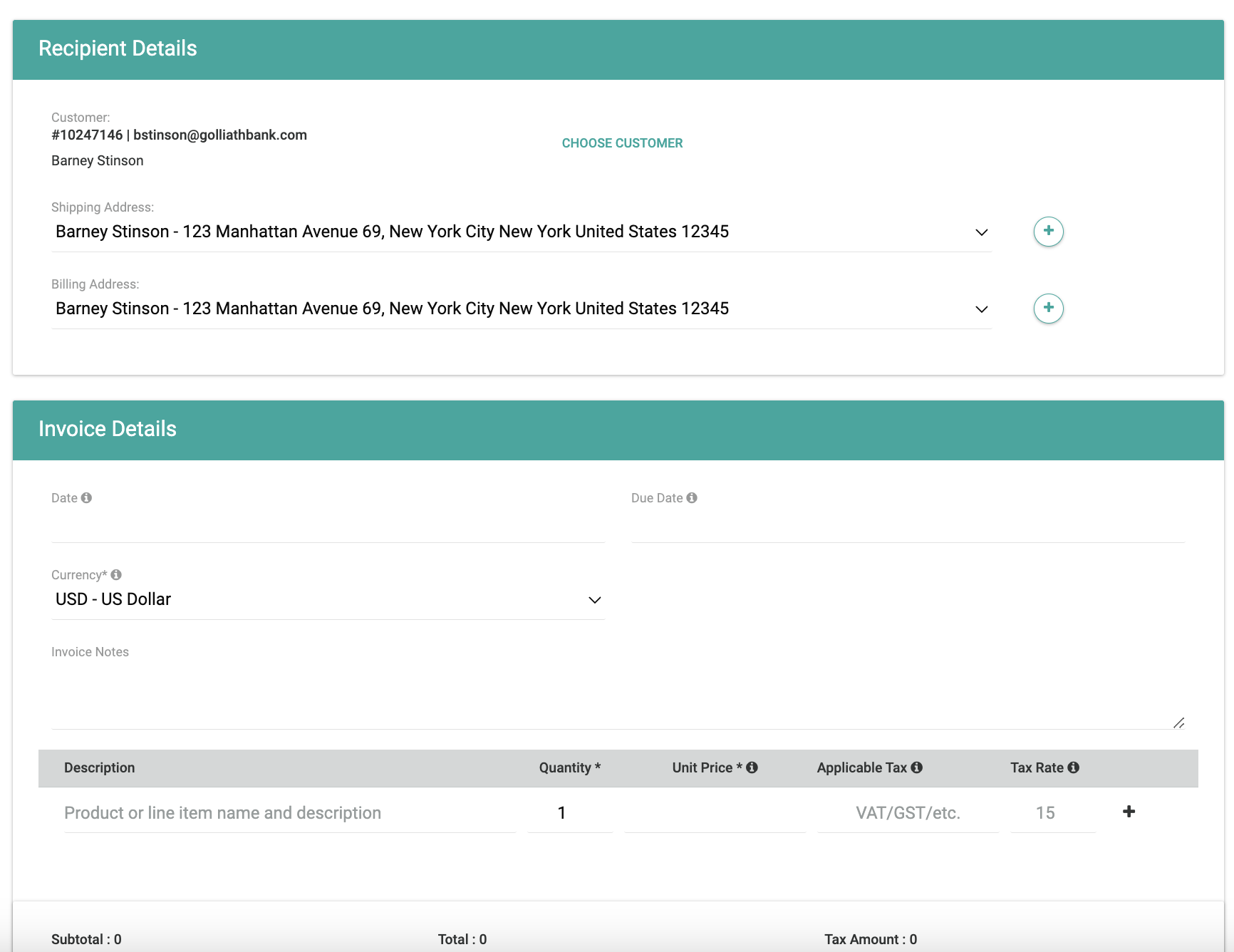
Invoice Actions by Status
Depending on the current status of your invoice, you can take a specific action or change the status of the invoice to a different status, in line with the aforementioned invoice lifecycle. You can do this by navigating to the invoice details page, and clicking the three dots "···" menu to the right-most column of the desired invoice, followed by the desired action:
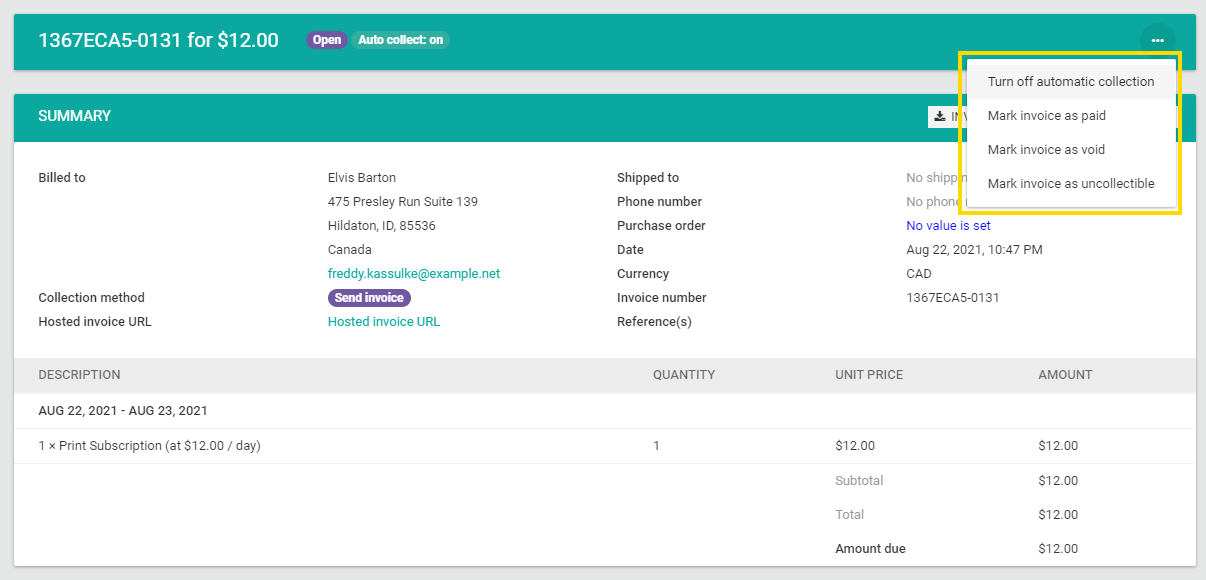
The below table will list all of the actions which you can do for each invoice status:
Status | Possible Actions |
|---|---|
Draft |
|
Open |
|
Past Due | No Actions Possible - You can't pay Past Due invoices from payment links or through the platform. |
Uncollectible |
|
Paid | No Actions Possible |
You can also action invoices using one of the following ways:
- Pelcro's JavaScript SDK
- Voiding Invoices: Pelcro's Core API
- Paying Offline Invoices: Pelcro's Core API
Charging Customer
You can immediately charge the customer for the draft invoice which is due immediately by choosing "Charge Customer". This will automatically deduct the invoice amount from the payment method on file under the relevant customer. You'll then see the confirmation screen where you can either confirm the charge or cancel as needed.
- If the payment is successful, the invoice status changes to "Paid"
- If the payment fails, the invoice status remains as "Draft"
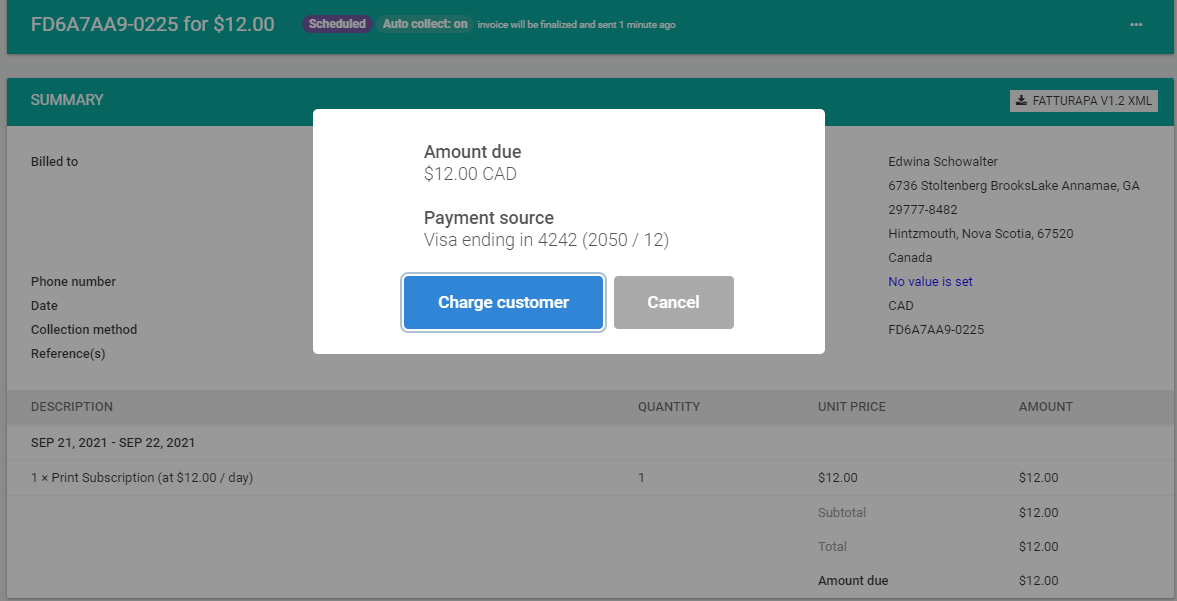
Turning on/off Automatic Collection
You can choose to control whether the payment due for the invoice is charged automatically from the payment source on file on recurring basis, or alternatively, manually on demand by toggling the setting for automatic collection under the invoice details view. When this feature is enabled, all of your customer's invoice's collection method will transition to Charged automatically whenever any subscription is renewed or a valid payment method is added.
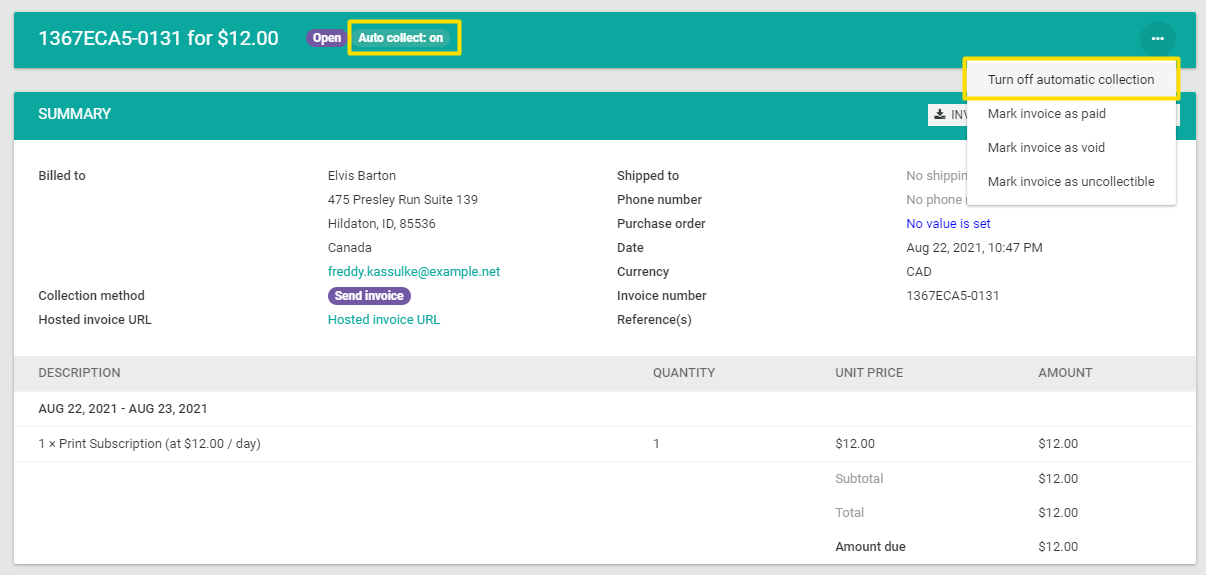
Marking Invoice As "Status"
You can change the invoice status directly through the invoice details view by choosing the corresponding option from the menu, as shown below.
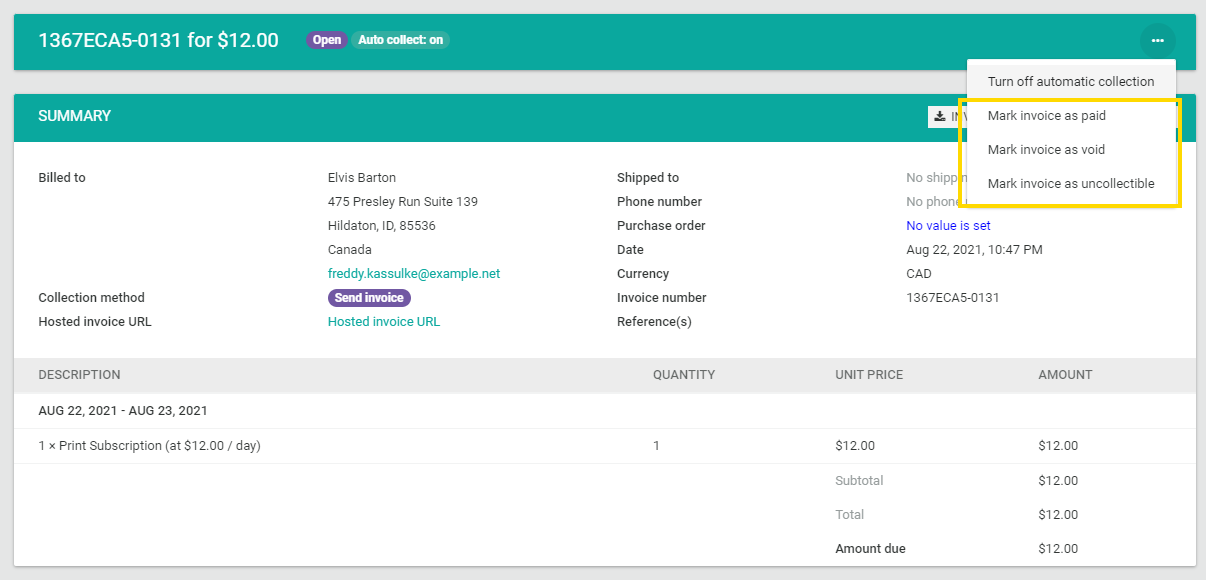
Invoice Settings
Automatic Uncollectible

- If an invoice has a Due Date, the platform uses that date to determine when the invoice becomes uncollectible.
- If no Due Date exists, the invoice’s Created Date is used as the effective due date.
- The invoice is marked uncollectible only after the configured Auto-Uncollectible Days have elapsed based on the applicable date.
Charge Customer upon Renewal
When the option for "Charge upon renewal" is enabled within Billing Settings for your site, payments will be collected when a customer decides to renew their subscription immediately once the renewal has been created on a customer record. This will reflect the amount on the customer's account balance, instead of having to wait for collecting the payment on the requested renewal start date.
There are two applicable collection methods provided to choose from:
- Apply to only subscriptions with collection method set to paying manually (Default): If the subscriptions you have are set to manual payments and you want to activate automatic charges when you add a card for renewal, then this is the right option to choose.
- Apply to all subscriptions.

Upcoming Invoice notifications

When the option for "Upcoming invoice notifications" is enabled within billing settings for your site, webhook notifications are triggered when customers invoice due date is coming up. You can configure this setting on two different levels.
- Global level: This is set directly from the setting itself, where you can choose to have the webhook notification triggered either 7 days or 30 days ahead of the invoice due date. This will apply to all of your active subscriptions.
- Plan level: This is set from the plan optional settings, where you can override the global setting to have the webhook notification triggered within a custom number of days ahead of the invoice due date. This will apply to active subscriptions to the configured plan.
Note that this setting will override Stripe settings for invoice notifications.
Invoice PDF settings
To customize your generated invoice PDFs, follow these steps:
- Navigate to the Settings section of your account, under Account Settings, select Invoicing. This will direct you to the Invoice Settings page.
- Customize Your Invoice Fields: You can configure the following details to be displayed on your PDF invoices:
- Header Memo – Add a note or message at the top of the invoice if any.
- Footer Memo – Include any additional information at the bottom of the invoice if any.
- Support Email – Set an email address where customers can reach out for support if any.
- Support Address – Display your company's physical address for contact purposes if any.
- Support Phone – Provide a customer service phone number if any.
- Support URL – Add a website link for customer assistance if any.
- Default Statement Descriptor – Define how your business name appears on customer statements if any.
- Privacy Policy – Link to your company’s privacy policy if any.
- Terms of Service – Include a link to your terms of service if any.
- Payment Button Link:
- Choose where the "Pay Now" button on your PDF invoices directs customers:
- Through your website: Ideal if you have a dedicated payment page.
- Pelcro payment portal: Leverage Pelcro's secure payment page.
- Payment gateway link (Stripe Only): Link directly to Stripe's payment page (requires Stripe integration). Please note that for Pelcro owned invoices this payment gateway link will redirect you to Pelcro's secure payment page.
- Choose where the "Pay Now" button on your PDF invoices directs customers:
Once you've customized these fields, your generated invoices will include the updated details automatically.
Updated 19 days ago
